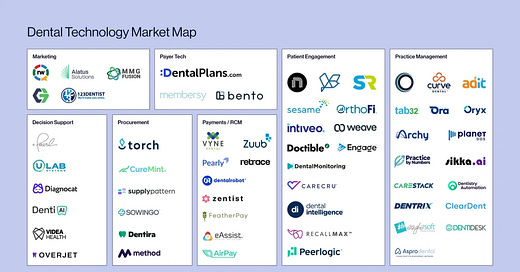One of my first "jobs" was working in my Mom's dental office some 20+ years ago. The core responsibility I was initially tasked with was writing her 'recall' cards - postcards that communicate oral care reminders to patients.
I would write them by hand, and we would batch-mail my output at the end of each workday at the mail annex she co-located with (as an aside, a Mom business lesson, locating adjacent to a post office is an OG growth hack for constant foot traffic and net-new patient growth, but Lessons from Mom should make for a dedicated post for another day)…My starting salary was 10 cents a card! Talk about aligned compensation :)
I learned many things from that time in my life, but what remained particularly ingrained in me was just how hard solo practitioners must grind to scale and how painfully manual most providers' workflows are.
We're looking to back businesses that change that! The following post was shared on Ansa's blog on 12/25/2023, touching on some of the angles we're exploring.
***
As we enter the holiday season, we wanted to highlight an area we have been focused on at Ansa for the past few months: dentistry. Dentistry holds a special place for us at Ansa. Not only is it a field ripe for technological innovation, but it also resonates with us on a personal level. Marco’s mother is a dentist, and Duncan’s grandfather was a dentist. We know visiting the dentist isn't everyone's idea of a good time, but that speaks to the opportunity. We believe technology is the key to transforming dental visits from a dreaded chore into a surprisingly pleasant experience.
Ansa's View of the Dental Tech
Where Dentistry Sits Today
Dentistry represents a significant chunk of healthcare spending in the United States. Taking care of our teeth is one of a limited number of activities we do twice daily (and anyone who follows the recommended 2 minutes twice a day from the CDC will spend nearly 1,000 hours over their life span brushing their teeth), which drives home the importance of dental care in our daily lives.
There are over 185,000 practices and over 200,000 dentists in the United States to service this need. Over 25,000 students graduate from dental school annually. All focused on the importance of teeth and oral health. Dentistry is a huge, growing industry. This is particularly poignant considering the global scale of dental health issues, with an estimated 3.5 billion people facing oral health problems. Unsurprisingly, it is an industry that already supports massive, complex organizations selling into dentist’s offices like Henry Schein (NASDAQ: HSIC) and Patterson. As we explore investing in the space, we have seen a handful of ways to dramatically improve the revenue and profitability of these practices.
Trends Reshaping the Dental Industry
The Emergence of DSOs:
The rise of Dental Service Organizations (DSOs) marks a significant shift in the industry. High dental education costs have made it challenging for new graduates to start independent practices. Over the past 40 years, dentist’s incomes have tripled, but dental education costs have skyrocketed, rising 16 times. This steep increase in tuition makes it increasingly challenging for new graduates to start independent practices, as student loan repayments consume a larger portion of their income.
Many new dentists find joining existing practices, often DSOs, a more viable option. DSOs offer operational efficiencies and access to technological advancements, as highlighted in a 2023 report by the American Dental Association. The industry is witnessing a trend of acquisitions by large, equity-backed DSOs ranging from large consolidators like Heartland and Pacific Dental Services to more localized groups like Singing River Dental Partners. However, despite this consolidation, a significant majority of practices — 93%, according to Harris Williams — remain independent. This balance between DSO-driven consolidation and the persistence of independent practices marks a complex and evolving landscape in dentistry.
While some might decry the loss of many independent dental practices, consolidation by DSOs allows for more advanced procurement and a deeper focus on efficiency. While individual dentists primarily focus on providing dental care, larger Dental Service Organizations (DSOs) have the advantage of employing specialized roles such as heads of strategy, Chief Technology Officers (CTOs), and other administrative functions. These professionals dedicate their time and expertise to actively identifying and evaluating opportunities to enhance their practices' overall performance and efficiency. For young, high-growth technology companies, partnering with Dental Service Organizations (DSOs) presents an excellent opportunity to scale rapidly, bypassing the usual challenges of competing for a dentist's limited time and attention.
Increased Consumer Demand:
According to the 2023 State of America’s Oral Health and Wellness Report, 92% of Americans recognize oral health as crucial to overall well-being. This shift, especially among younger populations, is propelling a demand surge for quality dental services. This growing consumer focus is reshaping the industry, leading to an increase in preventative care services and a higher standard of patient experience.
Additionally, the aging US population is bringing dental health into sharper focus, similar to other healthcare segments. Age-related oral health issues are escalating the need for specialized dental services. A GSK study illustrates some of the generational differences in oral health - younger consumers tend to be more diligent in their dental hygiene practices and have a better understanding of the link between oral health and other health complications. Over time, an increase in the desire for high-quality oral health is a benefit to dentists and the technology companies serving them. The landscape is shifting towards a future where superior dental care is not just a need but a priority for a growing and diversifying client base.
Staffing Challenges Prompting Efficiency:
One of the most pressing challenges faced by dental practices is administrative staffing. A third of dentists report needing more dental hygienists or assistants, and a quarter of dentists need help finding a sufficient number of office or administrative staff. Adding to this issue, dental assistants and hygienists frequently cite being overworked as a primary cause of job dissatisfaction.
This challenge is intricately linked to the need for more efficient operational practices. By integrating AI and automation technologies, dental offices can alleviate the administrative load on their staff and improve overall operational efficiency.
Investment Focus Areas at Ansa
We're directing our investments toward areas where we believe technology can make a transformative impact:
AI and Dental Imaging: AI is revolutionizing dental diagnostics. Beyond aiding dentists, AI technologies that have been trained on multitudes of dental images can help patients and insurers understand dental conditions more clearly. They not only support diagnoses and improve dental workflows but also open up new revenue streams by identifying additional treatment opportunities and allowing for better patient communication. The value of AI in dental imaging lies not in replacing dentists' expertise. Instead, its strength resides in ensuring consistency across diagnoses, improving operational workflows, and elevating the quality of customer communication. Companies like Pearl, Videa, and Overjet are working to improve practice and dentist efficiency.
Innovations in Business Operations:
Transforming Procurement: The current procurement landscape in dentistry is largely controlled by a few high-margin resellers, offering limited differentiation in their products. The time is right for innovators like Torch to challenge incumbents with stronger, more intuitive, and more automated procurement technology.
Customer Engagement for the Digital Age: Digital marketing and customer communication tools tailored for dental practices are changing how clinics contact and interact with their patients. These solutions are about attracting new patients and building lasting relationships, ensuring patient satisfaction, and ensuring lasting care. Platforms like Peerlogic are a game-changer for busy dental offices, where administrative staff are often overwhelmed, ensuring consistent and effective patient interaction without adding to the staff's workload.
Modernization of Revenue Cycle Management (RCM) and Billing: The administrative side of dental practices, especially billing and reimbursements, is ripe for automation - particularly given advances in OCR and document ingestion. Traditional reimbursement workflows are typically labor-intensive and inefficient. Even modest improvements in these processes can yield significant time and cost savings. Automating these aspects of practice management with platforms like Retrace or Zentist not only streamlines operations but also allows dental staff to focus more on patient care and less on paperwork.
A Call to Action for Dental Tech Innovators
If you're a founder or innovator in the dental technology space, we want to hear from you. And if you’re building in the space and raising a Series A-C, reach out to duncan@ansa.co or marco@ansa.co.






